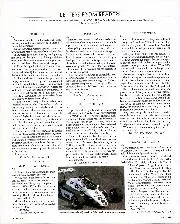
Pond memories
Sir, It was with great sorrow that my wife and I read of Tony Pond's death. In 1981, with co-driver Mike Nicholson, Tony drove the Dealer Team Vauxhall Chevette HSR…
[In continuing his series of articles on the technical side of sports car maintenance, Mr. F. T . Bersey discusses the ordinary methods of restoring compression by ordinary means and also explains the use and operation of specialised machinery used for the purpose.—EDITOR.
THE sporting motorist who looks after the efficiency of his engine by his own efforts, invariably pays a good deal of attention to the maintenance of high compression in order to obtain the very best power output, and quite a lot can be done provided the factor of wear has not become too serious.
The ordinary methods of improving compression by such operations as valve grinding, the reduction in the thickness of cylinder gaskets and so on, are things which can be carried out in the amateur garage without any trouble, but even these can only be accomplished successfully if a reasonable amount of care is exercised with regard to all the details of the work.
The ordinary means for restoring compression are so well known that they need not be included within the scope of these notes, my principal object being to explain the various methods of eliminating such wear as is beyond the average motorist-mechanic to cure. Up to certain limits, compression can be improved by simple measures ; but once these limits have been passed, there is nothing for it but to fall back on specialised machinery, some examples of which are illustrated herewith. After an engine has been run for about 10,000 to 15,000 miles, the piston clearance usually increases from the ordinary working limits to from .008 in. to
In passing, I may mention how easy it is to snap piston rings whilst engines are being assembled and even high-class mechanics are not always immune from accidents. It is, of course, an easy matter to guide the rings into the cylinder bores if suitable piston sleeves are used, but it is not worth while to make a set of these sleeves to suit one particular engine that may be in course of overhaul in a private garage. The difficulty can be overcome, however, if the usual process of engine assembly is reversed and after the connecting rods have been fitted, the pistons are fixed to the rods and entered separately into the cylinders. The cylinder block, together with the connecting rods, is then lowered on to the base chamber and the bearing caps coupled up from beneath, which greatly simplifies the work where side valve engines are concerned.
.0’0 in., which excessive clearance causes serious losses of gas past the pistons, high consumption of lubricating oil and rapid carbonisation in the combustion heads. In some cases the falling off of power can be obviated by the adoption of special piston rings, of which several forms are on the market, but more generally bad cases of cylinder wear can only be dealt with successfully by regrinding the bores and fitting over-size pistons. One of the most important details of cylinder grinding work is that of performing the operating on all the bores at one setting of the machine, thus ensuring perfect alignment, together with necessary accuracy of finish. Until the introduction of the latest forms of cylinder grinding machines, it was a matter of some difficulty to secure perfectly true surfaces, with a degree of finish desirable on high efficiency engines, which led to the